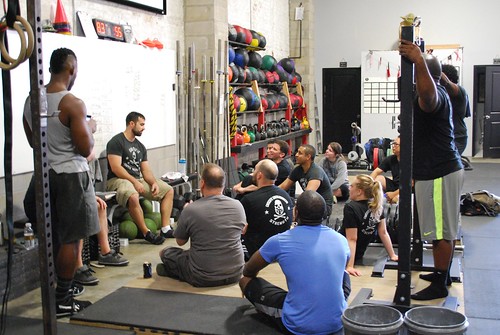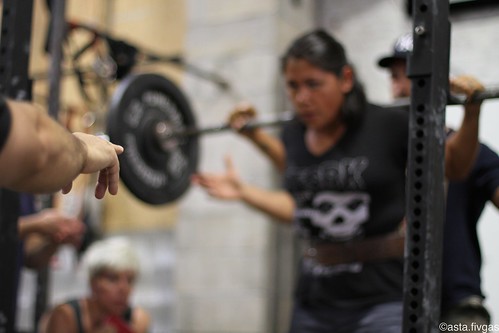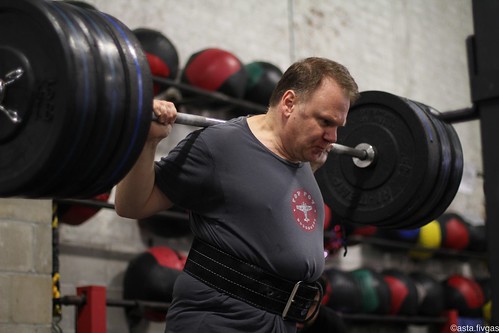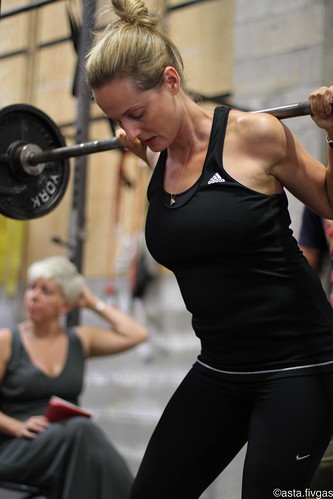How to Run a Dedicated Strength Program at your CrossFit Gym
 Monday, August 18, 2014 at 12:00AM
Monday, August 18, 2014 at 12:00AM 
When Earl L. began Strength Cycle at CFSBK in the early spring of 2012, he weighed 175 pounds and had been CrossFitting for three years—but knew he needed to get stronger. He already worked as a private military contractor, but decided to treat the program like another job, rather than just “going to the gym,” which meant he began eating more (viewing steak as a staple), quit drinking, and slept as often as possible. Within eight weeks, he took his totals from 275 on squat, 125 on press, and 335 on deadlift to 355, 165, and 405 (respectively). He also gained 23 pounds of mostly lean body mass. Earl’s story is a powerful example of the efficacy of Strength Cycle, and demonstrates why we stand behind this program so strongly. Last week, we discussed the origin and basic overview of Strength Cycle program run by coach Jeremy Fisher. If you missed that article, please check it out to gain a more context before digging into the logistics of how to run the program, which we’re sharing this week.
Originally, CFSBK started with one cycle that met three times per week and only included novice-level programming. As time went on and more people ended up sticking around to perform consecutive cycles, we gradually expanded the program to include alternative hours, different levels of programming, and a two-time per week version for those who still wanted to bias the lifts but also include some CrossFit into their training. In this week's article, we're addressing in more depth how CFSBK runs Strength Cycle, focusing on logistics, programming, and coaching. We also provide some case studies, just to make sure you’re thoroughly convinced.
3x Week Cycles:
These consist of three 90-minute classes on either Monday, Wednesday, and Friday or Tuesday, Thursday, and Saturday. They run for eight weeks with participants paying $300 at the start of the cycle and another $300 at the halfway mark. Because we want to prioritize strength development, individuals in these cycles are not permitted to take CrossFit group classes on top their three lifting days. If people have the desire to train outside of Strength Cycle, that desire usually wanes quickly as the intensity of the program gradually increases and ample recovery is required for tackling upcoming weight increases.
2x Week Cycles:
This cycle also involves 90-minute classes, which meet on Monday and Wednesday or Tuesday and Thursday. This version of the program costs $200 for four weeks (so $400 total) and runs concurrently with the three-times per week cycle. This option can be coupled with a CFSBK Group Class punch card so that participants may add in some more conditioning or Olympic lifting to their training. Alternatively, some lifters choose to freelance their additional programming at our biweekly Open Gym classes.
For both cycles, lifters commit to the entire eight weeks and short of extenuating circumstances, are automatically charged for the second half at the four-week mark. As mentioned last week, each eight-week cycle culminates with lifters from all the cycles coming together to perform an optional CrossFit Total.
 Programming
Programming
Jeremy keeps track of and programs everyone's work sets each week in his famous big green binder. As we mentioned last week, Strength Cycle’s methodology is based on Mark Rippetoe's Starting Strength program—a program we have found to be incredibly consistent in delivering exactly what it promises: getting really strong. If you're not familiar with this protocol or the nuts-and-bolts of how to correctly perform the basic barbell lifts, please do yourself and your clients a favor and order a copy of the book now. Even if you never intend on doing a dedicated strength program at your affiliate or with your clients, the basic pedagogy of how to think about, program, and teach the lifts in this book is invaluable for any serious coach.
Below, Jeremy addresses the exact logistics of how he determines each participant’s work sets for the cycles:
For CrossFit newbies or people who sign up for the program without any serious training experience, I'll start everyone with a linear progression. We begin by performing the exercises with the empty bar, then titrate to a reasonable starting weight and proceed from there. For people who have been doing CrossFit for a while but haven't really exhausted their linear progression in group classes, I'll take their five rep max, or estimate it if they don't have one, and then bump it down around 30 to 40 pounds or so. I like to give them about eight workouts before they're at or near their old 5RM. Smaller or weaker people will get a smaller drop on their starting weight, but they'll also be performing smaller jumps each week, perhaps 2.5 or five pounds. That's heavy enough that they're doing the work but light enough that they can develop their technique and acclimate to squatting three times per week.
With the intermediate lifters, I get to play with their training variables a little more. We'll start with a short linear run-up to get everyone back to speed if they've taken any breaks from training. After that, we settle into a pattern of High Volume on Tuesday, Recovery on Thursday, and Intensity on Sunday. The High Volume days are a mix of 5x5 (which is difficult to get done in the time constraints of a 90-minute class) and some volume ladders. Recovery day is based around paused squats, of which I've become a big fan. They get people more aware of their depth, they're extremely helpful for squatters who depend on their rebound, and they allow lifters to work hard with lighter loads. Intensity day is straightforward—heavy 5s, 3s, or doubles depending on where we're at in the cycle. We also move the deadlift to the middle of the week in order to have it align with the lightest squat day.
A large part of Strength Cycle (which benefits novices the most) is the education Jeremy provides alongside his guidance about each participant’s work weights. Jeremy always explains or gives brief lectures about how and why he programs work weights, so that participants begin learning how to become more autonomous with their training, and become not just stronger, but more intelligent lifters.
While participants can’t go rogue and do whatever weights they feel like, they are expected to take ownership of their training by maintaining their own logbooks. As Jeremy says, “Even though I keep track of everyone's numbers, I don't expect that they will be training with me through the rest of their life, so participants logging workouts is a necessary habit to being able to continue on in their training beyond the strength program. I'm a firm believer in the idea that most of the answers to your training questions are found in your own logbook, but you need to write the book first.”
 Coaching
Coaching
At CFSBK, Strength Cycle is limited to three platforms and one coach, which is why we cap each of the four cycles at eight lifters. Each class starts with some basic movement prep before getting right into the lifts. As we mentioned previously, 90 minutes can be a tight timeframe within which to get all the work accomplished, especially as the cycle progresses with heavier weights and longer rest periods. Athletes with movement restrictions know that they need to come in early and mobilize ahead of time so that Jeremy can focus on their lifts. Once everyone gets to the platforms, Jeremy writes everyone's work weights on the white board so lifters can get on top of their warm-ups and lifts while he makes the rounds monitoring everyone's training.
Of course, as with any group-based program, things aren't always as straightforward as you'd like them to be. In Jeremy’s words:
Some lifters, especially those who are new to the program, demand more of your time because of a lack of experience, mobility, body awareness, or sometimes all three. If given the chance, they will inevitably screw something up with their set-up, warm-up lifts, or movement, and as a coach, you need to tune into these people more acutely. At the same time, you can't babysit everyone through each and every warm-up rep, because there are seven other people who deserve your attention. I like to see every work rep in group classes, and I usually do. You have to make sure you give newbies extra attention where it's needed, while not shortchanging the more experienced folks who will at times have questions or need an eye on something.
 Conclusion and Case Studies
Conclusion and Case Studies
So that, in a nutshell, is how we organize and run CFSBK’s dedicated strength program. It's worked great for us and the program has always sold extremely well since initiating it almost five years ago. The program has helped diversify our membership options, opened our doors to a different population of lifters, and gotten a lot of folks much, much stronger. More powerful than words, we'll let some of the numbers for four typical case studies speak for the program.
Andrew C | Age: 30s | Weight: 220ish
Started out in August 2013 after a long period of inactivity. Initial work sets were squat 115x5x3, press 65x5x3, Deadlift 135x5x3. Participated in 3 straight cycles and 6 months (February 2014) later, his working weights were 340x5, 150x5, and 355x5 (respectively) and he totaled 390/180/430.
David T | Age: 44 | Weight: around 240lbs
Started September 2011. Came in with a squat at 200, press of 100, and a deadlift at 255. At his first total (eight weeks later), he hit 285/135/350. Last total in July 2013 was 410/165/455.
Bina A | Age: 40ish | Weight: 110lbs
Starting weights were squat 45x5, press 25x5, deadlift 95x5. Finished the cycle working at 140x5, 55x5, 160x5, and totaled at 165/55/190. Started off as a very small, unsteady, true novice. Finished with a small weight gain, became a much better mover, and demonstrated sizable increase in confidence on and off the platform.


Reader Comments (2)
Hi, my name is Stella, and I'm a strength cycle addict.
To those CrossFit gyms that want to add something like this -- and I'd like nothing better than to see strength cycles popping up all over America -- I would say that the right coach is of paramount importance. The reason strength cycle works so consistently is that Jeremy is watching every rep, paying attention to how each lifter moves, and taking notes for future reference. If my last set of cleans looked wobbly, then I can expect that the next time I walk into the gym to clean, I won't get to go up in weight (or I might even have my weight dialed back). If a lifter has begun to fail at linear progression, next time he programs rep outs at a lighter weight, or sets of 3 instead of 5, or something else based on his knowledge and observations.
To the three case studies I'll add my own: I went into my first strength cycle as a 140# woman squatting 105x5, pressing 55x5x3, deadlifting 155x3. After two cycles in a row back then, I got to a 500-pound Total (190/80/230). Two years later, I went in having upped my numbers to 215/90/255. I really thought I was close to maximizing my potential and then Jeremy added THIRTY-FIVE POUNDS to my squat (and 25 to my deadlift). I blew past my 600# Total goal, signed up for another cycle, and can't wait to see where it takes me.
zachadean e3d3fd1842 https://gsmile.app/bartredema